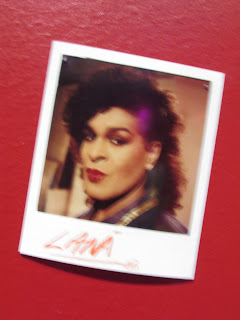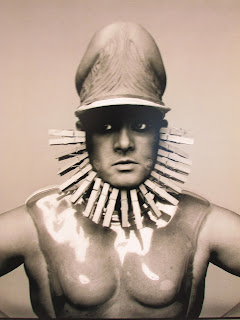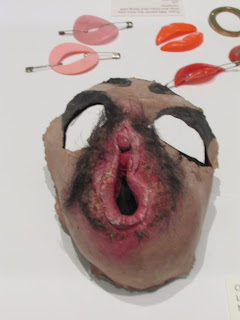"You wouldn't be interested in me if I didn't look the way I do. Let's face it, nobody would... There is a culture of individuality in London, and I feed into that. I couldn't do this anywhere else." - Leigh Bowery.
There was a great sense of anticipation on my part for this exhibition looking at the life and costumes of the one and only Leigh Bowery (1961-1994) and it didn't disappoint. There have been others of course here, and here examining aspects of Bowery's career, but this is the most comprehensive survey of the designer, performer and club scenester's short life staged in the UK to date. It gives an overview of Bowery's life and the huge impact he made on the London art, club and fashion scenes of the 80s and 90s, before his life would be cut short due to complications with an AIDS-related illness in 1994. The exhibition opens with a look at ephemera such as childhood photos, a college diploma and pair of silver hot-pants from Bowery's early years in Sunshine, Melbourne, from which he escaped to London with a list of resolutions - 1. Get weight down to 12 stone, 2. Learn as much as possible, 3. Become established in the world of art, fashion or literature, 4. Wear make-up everyday. Bowery was fortunate to arrive in London at a time when youth culture was about to explode with the arrival of magazines such as The Face and ID, clubs such as Blitz, and Taboo, (Bowery's own club night), and he seized the moment and made it his own with a highly unique, outrageous personal aesthetic. He was aided and abetted in this with friends and collaborators such as Trojan (who would die from an overdose in his early twenties), Boy George and dancer Michael Clark for whom he would design stage costumes and perform as a dancer. Bowery's performance Mirror, at the Anthony D'Offay Gallery in which he performed posing and preening on consecutive days in a series of his "Looks" in front of a two-way mirror unaware of who was watching on the other side, was one that I was privileged to witness whilst at art school, and one that brought Bowery to the attention of painter Lucian Freud who admired Bowery's bulk and dancers calves. Bowery went on to model for Freud and the exhibition contains some of the evidence of their collaborations captured in some of Freud's most striking oil paintings. Most impressive though here are the costumes Bowery created and wore to promote himself as a living work of art, and the iconic photography capturing the man and his individual looks by photographers like Nick Knight and Fergus Greer. The impromptu Polaroids documenting Bowery's looks in nightclubs taken by friends are also an invaluable part of this legacy and very much capture the essence of the period. Perhaps some of the most shocking images to my eyes, (spraying the audience of a gig in Brixton with an enema aside!) are those of Bowery on holiday in Cornwall in normal everyday dress without the make-up and the sequins where he looks positively plain, and dare I say it - ordinary. There is one in which he wears a wig where I could not help but draw comparisons between himself and Andy Warhol. What was really nice about this exhibition is that we get a sense of actually inhabiting Bowery's outrageous world, his shared Stepney flat covered in Star Trek wallpaper, where he was able to give free rein to his vision, dreaming up and creating the most outlandish outfits. The film of Bowery and friends here getting ready to go out clubbing is both really funny and catty as you would expect from that crowd. This is a quite an unusual exhibition by Tate standards and it asks the question of what Bowery actually was in terms of the canon of art. I guess it doesn't really matter. Bowery embodied dress and performance as an art, inspiring fashion designers, photographers and artists. The world of art, design and club culture in Thatcherite 1980s/90s London would have been a much poorer, less flamboyant place without his larger than life presence and contribution.
until 31st August
Tate Modern
Bankside
London
SE1









































































































No comments:
Post a Comment